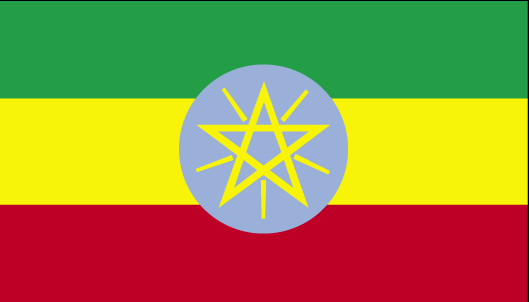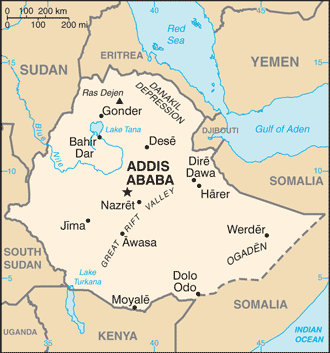
|
|
Advertisements:
People And SocietyNationality
Noun Ethiopian(s)
Adjective Ethiopian Ethnic groups
Oromo 34.5%, Amara 26.9%, Somalie 6.2%, Tigraway 6.1%, Sidama 4%, Guragie 2.5%, Welaita 2.3%, Hadiya 1.7%, Affar 1.7%, Gamo 1.5%, Gedeo 1.3%, other 11.3% (2007 Census) Languages
Oromigna (official regional) 33.8%, Amarigna (Amharic) (official) 29.3%, Somaligna 6.2%, Tigrigna (official regional) 5.9%, Sidamigna 4%, Wolayitigna 2.2%, Guaragigna 2%, Affarigna 1.7%, Hadiyigna 1.7%, Gamogna 1.5%, other 11.7%, English (official) (major foreign language taught in schools), Arabic (official) (1994 census) Religions
Orthodox 43.5%, Muslim 33.9%, Protestant 18.6%, traditional 2.6%, Catholic 0.7%, other 0.7% (2007 Census) Population World Ranking: 14
91,195,675 (July 2012 est.)
Note Estimates for this country explicitly take into account the effects of excess mortality due to AIDS; this can result in lower life expectancy, higher infant mortality, higher death rates, lower population growth rates, and changes in the distribution of population by age and sex than would otherwise be expected Age structure
0-14 years
46.3% (male 20,990,369/female 21,067,961) 15-64 years 51% (male 22,707,235/female 23,682,385) 65 years and over 2.7% (male 1,037,488/female 1,388,301) (2011 est.) Median age
Total 16.8 years
Male 16.5 years Female 17.1 years (2012 est.) Population growth rate World Ranking: 5
3.179% (2012 est.)
Birth rate World Ranking: 6
42.59 births/1,000 population (2012 est.) Death rate World Ranking: 44
10.79 deaths/1,000 population (July 2012 est.) Net migration rate World Ranking: 113
-0.01 migrant(s)/1,000 population Note Repatriation of Ethiopian refugees residing in Sudan is expected to continue for several years; some Sudanese, Somali, and Eritrean refugees, who fled to Ethiopia from the fighting or famine in their own countries, continue to return to their homes (2012 est.) Urbanization
Urban population 17% of total population (2010)
Rate of urbanization 3.8% annual rate of change (2010-15 est.) Major cities - population
ADDIS ABABA (capital) 2.863 million (2009) Sex ratio
At birth 1.03 male(s)/female
Under 15 years 1 male(s)/female 15-64 years 0.96 male(s)/female 65 years and over 0.75 male(s)/female Total population 0.97 male(s)/female (2011 est.) Maternal mortality rate World Ranking: 31
350 deaths/100,000 live births (2010) Infant mortality rate World Ranking: 14
Total 75.29 deaths/1,000 live births
Male 86.03 deaths/1,000 live births Female 64.23 deaths/1,000 live births (2012 est.) Life expectancy at birth World Ranking: 195
Total population 56.56 years
Male 53.99 years Female 59.21 years (2012 est.) Total fertility rate World Ranking: 12
5.39 children born/woman (2012 est.) Health expenditures World Ranking: 170
3.6% of GDP (2009)
Physicians density
0.022 physicians/1,000 population (2007) Hospital bed density
0.18 beds/1,000 population (2008) Hiv/aids - adult prevalence rate
NA
Hiv/aids - people living with hiv/aids
NA
Hiv/aids - deaths
NA
Major infectious diseases
Degree of risk High
Food or waterborne diseases Bacterial and protozoal diarrhea, hepatitis A and E, and typhoid fever Vectorborne diseases MalariaRespiratory disease Meningococcal meningitis Animal contact disease Rabies Water contact disease Schistosomiasis (2009) Children under the age of 5 years underweight World Ranking: 10
34.6% (2005)
Education expenditures World Ranking: 42
5.5% of GDP (2007)
Literacy
Definition
Age 15 and over can read and write Total population 42.7%Male 50.3% Female 35.1% (2003 est.) School life expectancy (primary to tertiary education)
Total 8 years
Male 9 years Female 8 years (2008) Unemployment, youth ages 15-24 World Ranking: 31
Total 24.9%
Male 19.5% Female 29.4% (2006)
Comments
Add a new comment: |
Advertisement
Members area
Ethiopia (Addis Ababa):
 
GPS points from Ethiopia (Addis Ababa)
|
||||||||

 Unique among African countries, the ancient Ethiopian monarchy maintained its freedom from colonial rule with the exception of a short-lived Italian occupation from 1936-41. In 1974, a military junta, the Derg, deposed Emperor Haile SELASSIE (who had ruled since 1930) and established a socialist state. Torn by bloody coups, uprisings, wide-scale drought, and massive refugee problems, the regime was finally toppled in 1991 by a coalition of rebel forces, the Ethiopian People's Revolutionary Democratic Front (EPRDF). A constitution was adopted in 1994, and Ethiopia's first multiparty elections were held in 1995. A border war with Eritrea late in the 1990s ended with a peace treaty in December 2000. In November 2007, the Eritrea-Ethiopia Border Commission(EEBC) issued specific coordinates as virtually demarcating the border and pronounced its work finished. Alleging that the EEBC acted beyond its mandate in issuing the coordinates, Ethiopia has not accepted them and has not withdrawn troops from previously contested areas pronounced by the EEBC as belonging to Eritrea.
Unique among African countries, the ancient Ethiopian monarchy maintained its freedom from colonial rule with the exception of a short-lived Italian occupation from 1936-41. In 1974, a military junta, the Derg, deposed Emperor Haile SELASSIE (who had ruled since 1930) and established a socialist state. Torn by bloody coups, uprisings, wide-scale drought, and massive refugee problems, the regime was finally toppled in 1991 by a coalition of rebel forces, the Ethiopian People's Revolutionary Democratic Front (EPRDF). A constitution was adopted in 1994, and Ethiopia's first multiparty elections were held in 1995. A border war with Eritrea late in the 1990s ended with a peace treaty in December 2000. In November 2007, the Eritrea-Ethiopia Border Commission(EEBC) issued specific coordinates as virtually demarcating the border and pronounced its work finished. Alleging that the EEBC acted beyond its mandate in issuing the coordinates, Ethiopia has not accepted them and has not withdrawn troops from previously contested areas pronounced by the EEBC as belonging to Eritrea.